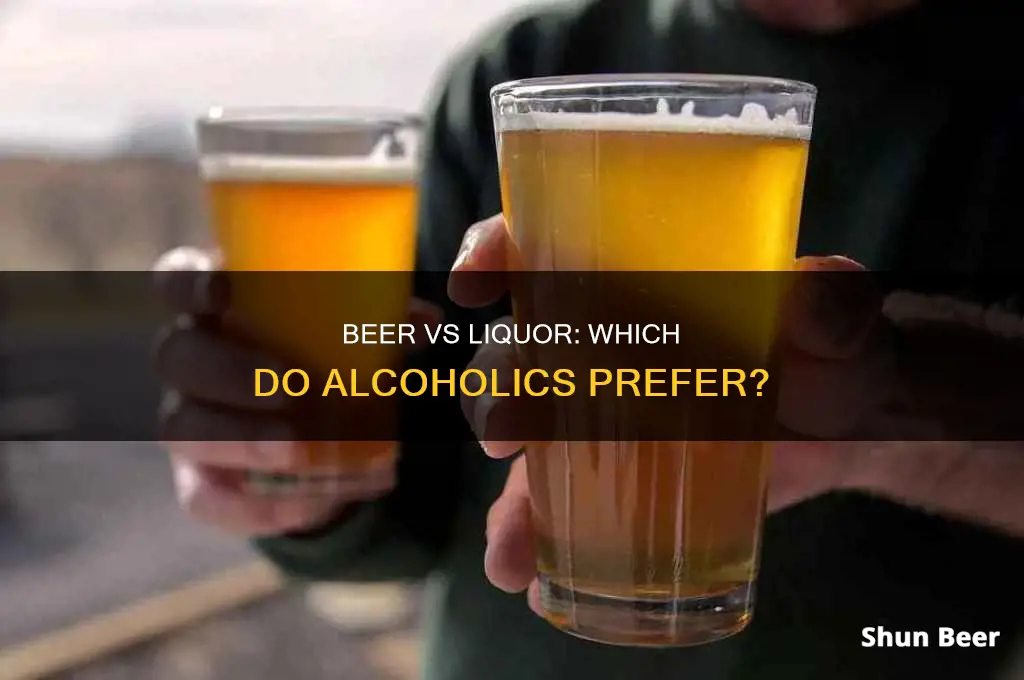
Alcoholism is a serious issue, with 16.3 million adults diagnosed with Alcohol Use Disorder (AUD) in 2014. Excessive alcohol consumption can lead to approximately 88,000 deaths per year and can negatively impact a person's life and health. While moderate drinking is normalised socially, binge drinking can lead to addiction and serious chemical dependence. Beer, wine, and liquor all have different alcohol contents and serving sizes, and it is important to understand these to gauge consumption. Beer typically has 5% alcohol content, wine 12%, and liquor/spirits 40%. However, serving sizes vary, with beer being served in 12-ounce quantities, wine in 5-ounce quantities, and liquor in 1.5-ounce shots. This means that a single serving of beer, wine, or liquor contains roughly the same amount of alcohol. Therefore, the number of drinks consumed is more important than the type of drink when it comes to alcohol consumption and addiction.
| Characteristics | Values |
|---|---|
| Alcohol by volume (ABV) | Beer: 3-7% ABV, with light beers at 2-4% ABV and regular beer at 5% ABV |
| Wine: 9-14% ABV, with fortified wines at 16-24% ABV | |
| Liquor: starts at 20% ABV, with some states allowing up to 95% ABV | |
| Serving size | Beer: 12 ounces |
| Wine: 5 ounces | |
| Liquor: 1.5 ounces | |
| Risk factors | Liquor is often masked in larger drinks, making it easier for individuals to consume more alcohol in a short period of time |
| It takes less liquor to cause the same effects as beer or wine, leading to quicker intoxication | |
| People tend to consume liquor more quickly, especially in shot form |
What You'll Learn
- Beer and liquor have different production processes, with beer made through fermentation and liquor through distillation
- Beer typically has lower alcohol content than liquor
- Liquor is often mixed with non-alcoholic drinks, which can make it easier to consume in larger quantities
- Excessive alcohol consumption can lead to similar negative health consequences regardless of the type of drink
- Binge drinking is defined differently for men and women and is a key factor in developing alcohol addiction

Beer and liquor have different production processes, with beer made through fermentation and liquor through distillation
Beer and liquor have vastly different production processes, with beer made through fermentation and liquor through distillation.
Fermentation is a biological process that uses yeast to convert sugars into alcohol and carbon dioxide. Brewers add yeast to a plant product, such as barley or other grains, and seal the container to induce fermentation. The yeast breaks down the sugars in the plants, resulting in ethanol, the main ingredient in alcohol production. The liquid is then extracted from the tank and processed further, and the beer is ready for human consumption.
Distillation, on the other hand, uses heat to separate various liquids. Distillers start by soaking and germinating the grain in water, then roasting and grinding it. The ground grain is then combined with water and yeast, and the mixture is heated to create an alcoholic beverage with a high proof. The vapour released during heating is condensed, and the liquid is collected. This process can be repeated several times to extract purer ethanol.
Liquor, also known as spirits, is created by distilling fermented drinks. For example, the distillation of beer wort creates whiskey, while the distillation of wine produces brandy. Distillation results in a higher alcohol content in the final product compared to fermentation.
While beer is typically made through fermentation, and liquor through distillation, it's important to note that fermentation plays a role in both processes. Fermentation is used to create the base alcoholic liquid, which is then distilled to create liquor.
The production processes of beer and liquor result in different alcohol contents. Beer typically has an alcohol content of around 5%, while liquor has a much higher alcohol content, ranging from 36% to 50% ABV or more. These percentages represent the volume of pure alcohol in the beverage, with the rest being water and other ingredients.
In summary, beer is primarily made through fermentation, which converts sugars into alcohol using yeast, while liquor is produced through distillation, a process that uses heat to separate liquids and concentrate alcohol. Distillation typically results in a higher alcohol content in the final product.
Beer After Hard Liquor: Is It Safe?
You may want to see also

Beer typically has lower alcohol content than liquor
Alcohol is a chemical and a psychoactive drug that has been consumed by humans for thousands of years. It is a beverage made from fermented grains or fruit. The type of alcohol consumed in alcoholic beverages is ethanol, which is produced by yeast during the fermentation process.
Beer, wine, and liquor are the three standard drink categories in the United States. Beer typically has a lower alcohol content than liquor. A standard beer, whether lager or ale, has between 4% and 6% ABV (alcohol by volume), although some beers have higher or lower concentrations. For example, light beers have between 2% and 4% ABV, while malt liquors have between 6% and 8%. In comparison, liquor has a higher alcohol content and is typically served in smaller quantities. For instance, a typical serving of liquor is 1.5 fluid ounces of distilled spirits, which contains about 40% ABV.
The higher alcohol content of liquor means that it takes less liquor to cause the same effects as a larger quantity of beer. This can lead to quicker intoxication. Additionally, liquor is often served as cocktails, where it is blended with non-alcoholic mixers, masking the taste of the alcohol and potentially leading to increased consumption. Beer, on the other hand, is typically served in larger quantities, such as a 12-ounce serving for a standard beer.
While beer generally has a lower alcohol content than liquor, it is important to note that the specific alcohol content can vary within each category. For example, craft beers can have an ABV of over 5%, and some liquors may have a lower ABV depending on the specific type and brand. Therefore, it is always important to check the alcohol content of any beverage and to consume alcohol in moderation.
Excessive alcohol consumption, regardless of the type of beverage, can lead to alcohol use disorder and have negative consequences on an individual's health, relationships, and productivity. It is important to drink responsibly and seek help if alcohol consumption becomes a problem.
Alligators and Beer: A Drinking Buddy?
You may want to see also

Liquor is often mixed with non-alcoholic drinks, which can make it easier to consume in larger quantities
Alcohol is a chemical and a psychoactive drug that has been consumed by humans for thousands of years. While moderate drinking in social settings is considered normal, it can become a habit, leading to binge drinking and addiction. Binge drinking is defined as consuming more than five drinks in two hours for men and more than four drinks in two hours for women.
Liquor, also known as hard liquor or distilled spirits, is produced by distilling grains, vegetables, or fruits and has a higher alcohol content than beer. It is often served as cocktails, blended with non-alcoholic mixers and ingredients to create unique flavours. This practice of mixing liquor with non-alcoholic drinks can make it easier for individuals to consume larger quantities in a short period. The taste of hard liquor can be masked by mixers, causing people to drink more than they usually would.
The higher alcohol content of liquor means that it takes less to cause intoxication compared to beer or wine. A typical serving of liquor is 1.5 fluid ounces, containing about 40% alcohol, while a typical serving of beer is 12 ounces with 5% alcohol content. This means that consuming the same volume of liquor would result in a significantly higher blood alcohol concentration compared to beer.
Additionally, liquor is often consumed in shots, allowing people to down multiple servings in a short time. The quick consumption of multiple shots can lead to a rapid increase in blood alcohol levels, potentially resulting in alcohol poisoning or other harmful consequences. Therefore, liquor mixed with non-alcoholic drinks can be a contributing factor to excessive alcohol consumption and related health risks.
Beer and Ozempic: Is It Safe to Drink?
You may want to see also

Excessive alcohol consumption can lead to similar negative health consequences regardless of the type of drink
Alcoholism is a disease that can harm individuals emotionally, physically, and spiritually. Beer, wine, and liquor are all types of alcohol that can lead to addiction and have negative health consequences. Moderate drinking is considered one drink or less per day for women and two drinks or less per day for men. However, excessive alcohol consumption, regardless of the type of drink, can lead to similar negative health consequences.
Excessive drinking can interfere with the brain's communication pathways, affecting mood, behaviour, and coordination. It can also damage the heart, leading to problems such as cardiomyopathy, arrhythmias, and high blood pressure. Heavy drinking also takes a toll on the liver, increasing the risk of liver inflammations such as steatosis, or fatty liver. Additionally, alcohol causes the pancreas to produce toxic substances, which can lead to pancreatitis, a dangerous inflammation that impairs the pancreas's function.
The National Cancer Institute has found a strong link between alcohol consumption and an increased risk of several types of cancer, including head and neck cancer, esophageal cancer, and breast cancer. Even moderate drinking can increase the risk of certain cancers. Alcohol consumption can also weaken the immune system, making individuals more susceptible to diseases and infections.
Excessive alcohol consumption can also increase the risk of accidents and injuries, violence and antisocial behaviour, unsafe sex, and unplanned pregnancies. It can also lead to social and personal problems, including family break-up and divorce. Furthermore, binge drinking, which is common among those with alcohol use disorder, can have particularly harmful effects on the body and increase the risk of alcohol poisoning.
Miscarriage Recovery: Beer and Alcohol Consumption
You may want to see also

Binge drinking is defined differently for men and women and is a key factor in developing alcohol addiction
Binge drinking is a key factor in developing alcohol addiction. It is defined as a pattern of drinking that brings blood alcohol concentration (BAC) to 0.08% or more, which typically happens when a woman consumes four or more drinks or a man consumes five or more drinks within about two hours. This definition is supported by both the National Institute on Alcohol Abuse and Alcoholism (NIAAA) and the Substance Abuse and Mental Health Services Administration (SAMHSA). Binge drinking behaviours can lead to serious chemical dependence and addiction, and this is true regardless of whether individuals choose beer, wine, or liquor.
The NIAAA defines "standard" drink sizes in the United States as follows:
- 12 ounces of regular beer, which is usually about 5% alcohol
- 5 ounces of wine, which is typically about 12% alcohol
- 1.5 ounces of distilled spirits, which is about 40% alcohol
However, it's important to note that the amount of liquid in a glass, can, or bottle does not always reflect the amount of alcohol it contains. For example, many light beers have almost as much alcohol as regular beer, at about 85%. Therefore, understanding the specifics of alcohol types and content is crucial for consumers to be aware of how much alcohol they are actually consuming.
Binge drinking is a concerning trend across all age groups, with about 61.4 million people in the United States aged 12 and older reporting binge drinking in the past month. While rates of binge drinking among preteens, teens, and young adults are decreasing, they remain high, especially among college students. Binge drinking among older adults is also a concern due to potential interactions with medications and increased susceptibility to alcohol-related falls and injuries.
The consequences of binge drinking can be severe and include acute harm such as blackouts and overdoses, as well as an increased risk of unsafe sexual behaviour, sexually transmitted infections, and unintentional pregnancy. Binge drinking also increases the likelihood of potentially deadly consequences such as falls, burns, drownings, and car crashes. Even a single episode of binge drinking can compromise immune system function and lead to acute pancreatitis in individuals with underlying pancreatic damage. Over time, repeated episodes of binge drinking contribute to liver and other chronic diseases, as well as an increased risk of several types of cancer.
To prevent the harmful effects of binge drinking, it is recommended to drink in moderation, with adults of legal drinking age limiting intake to two drinks or less per day for men and one drink or less per day for women.
Chickens and Beer: A Safe Combo?
You may want to see also
Frequently asked questions
Hard liquor, or distilled spirits, is made by refining grains, vegetables, and fruits. Examples include whiskey, gin, rum, brandy, tequila, and vodka. Beer, on the other hand, is made by extracting raw materials like malt, hops, or yeast using water and fermentation.
Beer and liquor pose similar health risks as they are made up of the same compounds. However, liquor has a higher alcohol content, making it more dangerous and addictive.
A shot of liquor can have a stronger effect than a can of beer, and its flavour can be masked by non-alcoholic beverages, making it easier to consume larger quantities.
Excessive alcohol consumption can lead to liver disease, impaired judgement, cancer, and an increased risk of premature death. It can also cause social harm, negatively impacting relationships and daily responsibilities.







